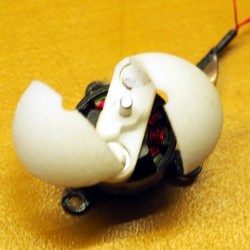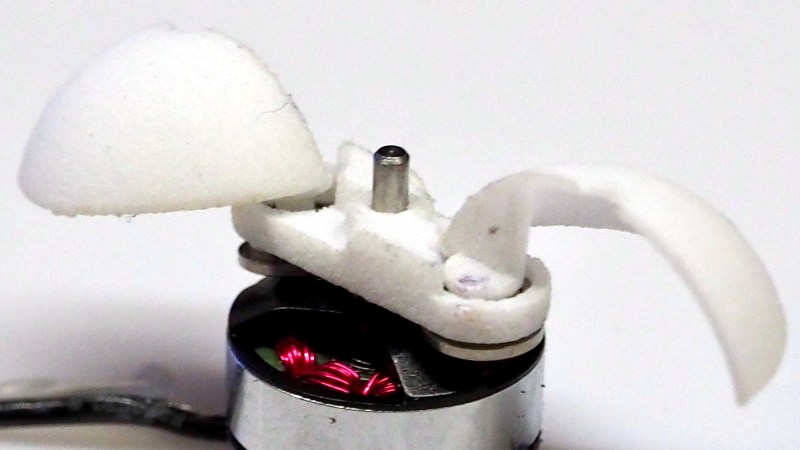 Careful planning and simulation is invaluable, but it can also be rewarding to dive directly into prototyping. This is the approach [Carl Bugeja] took with his Spherical Folding Propeller design which he has entered into the Open Hardware Design Challenge category of The 2018 Hackaday Prize. While at rest, the folding propeller looks like a small dome attached to the top of a motor. As the motor fires up, centrifugal forces cause the two main halves of the dome to unfold outward where they act as propeller blades. When the motor stops, the assembly snaps shut again.
Careful planning and simulation is invaluable, but it can also be rewarding to dive directly into prototyping. This is the approach [Carl Bugeja] took with his Spherical Folding Propeller design which he has entered into the Open Hardware Design Challenge category of The 2018 Hackaday Prize. While at rest, the folding propeller looks like a small dome attached to the top of a motor. As the motor fires up, centrifugal forces cause the two main halves of the dome to unfold outward where they act as propeller blades. When the motor stops, the assembly snaps shut again.
[Carl] has done some initial tests with his first prototype attached to a digital scale as a way of measuring thrust. The test unit isn’t large — the dome is only 1.6 cm in diameter when folded — but he feels the results are promising considering the small size of the props and the fact that no simulation work was done during the initial design. [Carl] is looking to optimize the actual thrust that can be delivered, now that it has been shown that his idea of a folding dome works as imagined.
Going straight to physical prototyping with an idea can be a valid approach to early development, especially nowadays when high quality components and technologies are easily available even to hobbyists. Plus it can be great fun! You can see and hear [Carl]’s prototype in the short video embedded below.



















Nice design. It looks like those blades would make better thrust in the water than in air but, this proves the concept and it looks great too.
Yeah, came here to say that it’s a cool idea but the angle of attack looks extremely aggressive.
That might have some interesting applications. The propeller could provide thrust, then fold up and minimize drag to allow the vessel to coast efficiently. Pretty neat.
Yes, I was thinking for use in a small craft like a kayak where the low drag when off would be very important. He should test that in water turning fairly slowly and I bet it would work pretty well as is.,,or with a little tweaking.
the PAL-V One used a similar propeller design: https://www.youtube.com/watch?v=_v1wc0bD_Cg @0:50
We eventually abandoned the concept in favor of a a more simple principle for weight, efficiency, robustness and certification reasons. it does work, there are some powered gliders that use it, but the hinges see the full flap moments on their hinges, in the wrong direction. they are in the right direction for lead/lag, which may be beneficial in some designs (pusher props, mainly). this design also sacrifices the inside third (at least) of the disk area, depending on the design this may matter or not. obviously all these things are nearing irrelevance with this small of a diameter:) proper aerodynamics still matter though, and quarter spheres are not it. looks cool though.
turning the hinges 90deg. means no more flap moments (given a 2 blade prop), but more importantly, the first and second bending modes are almost completely mitigated, leaving the third (bending of one blade. or the first mode of the blade itself) as the first. this can make for a way lighter design since the blades can no longer excite each other.
This is pretty cool but whats the purpose other than being cool? I kind of fail to see the application for this.
robot lady bugs. of course.
Durability perhaps? Though one could just make thicker props.
Maybe a self launching glider could make use of it as it would have less drag then a conventional prop with the motor off.
I’d like to see if an RC plane could fly with it.
that’s not a propellar, its a scoup. that won’t propell anything.
You seem to have a fundamental misunderstanding about how propellers work.
Propellers are made with airfoils, with differing shape, size and angle of attack from inboard to outboard along their length. They’re designed to produce thrust from their airfoil lift, as the propeller turns and their thrust moves the assembly through the air.
Scoops, well, they scoop. They’ll move some air and may make a useful fan. Lift/thrust? Not so much so. And it fades quickly as they start to move forward.
Now take that scoop and form it to have an airfoil… Won’t be the most efficient or effective, and there would likely be some issues with lift/thrust vectors, but it may be able to become useful beyond scooping some air. I’d be tempted to look at scimitar props, the more extreme ones that flex to change their angle of attack based on rpm; a flexible ‘dome’ prop, in addition to ‘opening’, may be able to change its shape to provide more useful lift/thrust vectors.
And although a well formed dome may be ideal for low drag while closed, a malformed dome that provides an open prop shape that is more effective may have sufficiently low closed drag that amply meets its original intent.
Interesting.
Reminds me of https://arstechnica.com/science/2018/03/earwigs-wing-inspires-compact-designs-that-fold-themselves/
Where are those animated GIFs when you need them? ;)
I appreciate what he’s trying to do…but no.
The 12 grams of thrust he is seeing is not enough to do any useful work. It says on the IO page he’s trying to make a pocket “drone” (so we’ll assume a quad), and that’s just not enough power. At least not at the scale he’s working at. Even if he somehow doubled the thrust with design tweaks, it simply isn’t enough.
Not to mention that from the video you can see the prop starts to fold back in when the throttle is reduced. Sort of a problem for an aircraft that relies on rapid throttle adjustments to fly.
This is a great idea for rocket launched RC motor gliders, where launch speeds make the cone a greater necessity than quality thrust afterwards. It would be interesting to see if the payoff of reduced drag at launch more than compensated for the lower propeller efficiency once the motor glider was released.